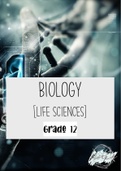Summary
Grade 12_Biology [Life Sciences]_Summary
- Course
- Institution
Detailed summaries of the Grade 12 Life Sciences / Biology syllabus (CAPS & IEB SAGS). Can be used for exam and test preparation. Compiled from various sources to enhance the learning experience and enrich the content of the summaries.
[Show more]



